Revision Rhinoplasty: Nose Reshaping in Harley Street, London
Revision rhinoplasty is the terminology for undergoing surgery after having a previous procedure on the nose, including previous rhinoplasty, septoplasty or substantial trauma.
FACELIFT SURGERY IN HARLEY STREET
What is Revision Rhinoplasty?
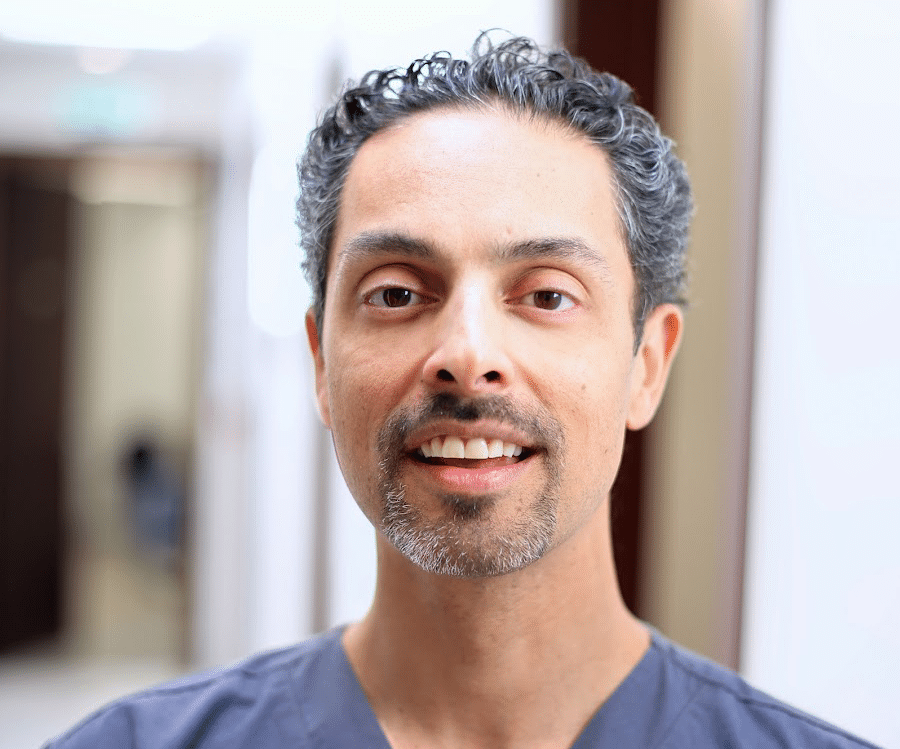
Revision rhinoplasty is the terminology for undergoing surgery after having a previous procedure on the nose, including previous rhinoplasty, septoplasty or substantial trauma.
The anatomy and soft tissues of the nose is intricate, and once surgery has been completed there is a degree of scarring and change in anatomy that is unique to each individual patient.
The level of scarring is dependent on multiple factors including the previous surgery, the surgeon, the ethnicity of the patient and their individual genetics and healing.
The treatment of patients who have undergone previous nose surgery is challenging and is dependent on the degree of change and patients’ expectations from surgery.
Although for most patients a substantial improvement can be made, the key to success is the achievement of patient’s expectations.
Approximately thirty percent of Dr De Silva’s patients are revision surgeries.
Rhinoplasty, a surgery to fix either the cosmetic defects or improve the function of the nose, is one of the most technically difficult surgeries. Patients may end up dissatisfied with their end results, and wish to fix their unsuccessful nose jobs, which has created a large need for secondary or even multiple surgeries.
Because nose surgery is a challenging procedure, if the surgeon is not sufficiently skilled or experienced, patients can end up with breathing problems or dissatisfaction with the cosmetic appearance of their nose. Revision surgery seeks to solve these problems, and as each case is unique, the techniques used will also vary per patient. A previous surgery complicates any further work, which is why revision rhinoplasties can add more difficulties to an already demanding surgery. That is why it is important to choose a surgeon who has a great deal of technical skill, knowledge of the latest techniques, an artistic touch, and extensive experience, especially with dealing with the patient’s specific ethnic group and problem.
Simpler cases will remove some excess tissue or cartilage that was missed in the first surgery. There are also cases of straightening out a crooked nose, and the most complicated cases will require a complete overhaul of the nose.
There are also further limitations on a rhinoplasty in London that was not present in an original surgery: scar tissue may have built up to a point where surgery is inadvisable, or the skin in the area may be compromised or insufficient. Revision surgery can be very challenging with a combination of scar tissue and a change in natural anatomy, realistic expectations are an important consideration.
Why Choose Dr De Silva in Harley Street, London ?
Dr De Silva is a widely credited and celebrated facial plastic surgeon who specialises in the eyes, nose, face and neck areas only, and is known for natural results.
“My focus has and always will be to be the very best at what I do, to continually innovate to provide World Class leadership to all my team, all my patients and all my associates. My mission is to help every patient be the very best version of themself with World-Class services, life-long follow up with complimentary facial aesthetic procedures.”
In a world of increasing complexity and misinformation, his passion has been focused on providing sincere advice, low risk and fast recovery procedures.

Facelift & Facial Only Treatments
By focusing entirely on only facelift & facial cosmetic surgery procedures, Dr De Silva is able to provide the expertise that can only come with specialisation: facelift and neck lift, blepharoplasty, rhinoplasty and chin implants.
Natural Looking Results
Dr De Silva is a believer in the importance of artistry behind cosmetic results and focuses his skills at delivering natural looking results.
Fast Recovery
Dr De Silva has pioneered the advances in technology to speed up recovery with a combination regenerative medicine techniques, Oxygen and LED Therapy.
World Class Expertise
Dr De Silva also teaches other surgeons internationally and has contributed to the development of advanced surgical techniques, laser technology and stitch-less tissue adhesives.
Nose Reshaping Technique And Procedure
Reduced Breathing After Surgery?
Commonly patients come to see Dr De Silva improve both their breathing after undergoing the previous surgery. To assess breathing requires an assessment in person and cannot be completed with photographs or imageing alone. For specific patients’ further tests may be required to evaluate the cause of their reduced breathing and include a CT (computerised tomography) scan.
Although measures can be taken to preserve breathing during surgery, rarely breathing maybe be compromised as the nose has been reduced in size. Additional measures including the use of graft material are often required to improve breathing in revision cases.
Recovery Time After Revision Surgery?
Often recovery time is longer with revision surgery as a consequence of increased swelling and scar tissue. After surgery, Dr De Silva uses specialised anti-inflammatory medications to enhance recovery and has pioneered the use of regenerative medicine in the UK.
How Long Does Revision Surgery Take?
Revision surgery is an outpatient procedure and can take between three to four hours. The surgery takes approximately 30-50% longer than a primary rhinoplasty.
Nose Reshaping Questions
What Are Common Indications for Revision Surgery?
- Revision to the nasal tip (pinching, asymmetry, inadequate projection of tip), bridge of the nose (irregularities, Polly beak fullness, saddle depression, residual nasal bump, wide-open roof), nostrils (asymmetry, flaring, collapse) size of the nose (too short, too long), breathing difficulty). Most of these complications are minor and can be easily corrected and may occur in the best of hands as a patient’s healing process play an important role in results.
- Each revision surgery is unique and requires customised treatment with respect to the position, shape, scarring and function of the nose.
Can Revision Rhinoplasty Always Be Completed?
Dr De Silva is able to achieve excellent results and will operate on cases where he feels he can achieve a success that is within the patient expectations, if he cannot achieve this he may advise against further surgery.
Dr De Silva asks some patients to send information such as medical history and photographs of their nose in advance of a consultation to ensure that we are able to help.
What is Different in Revision Surgery?
- Revision rhinoplasty is a more complex procedure with the presence of scarring and a change in the natural anatomy of the nose and often requires additional specialist techniques to improve the aesthetic result.
- For some patients, Dr De Silva imports specialist graft material from the US to improve the final result for some patients, and other techniques may be required such as the use of the patient’s ear cartilage to support a long-lasting result.
- As a consequence of having a previous procedure on your nose, the recovery after revision surgery can be longer as swelling can longer to resolve, for some patients the use of anti-swelling medicine after surgery can be a powerful tool to speed up recovery after surgery.
- The nose is an intricate part of the face with unique anatomy and function, millimetres are the difference between success and failure.
- The nose has an important function in breathing and Dr De Silva often takes additional measures to improve the function of your nose.
World Class Facial Cosmetic and Plastic Surgery
Rhinoplasty Before & Afters
Dr De Silva has transformed thousands of faces through his unique surgical techniques. Below is a small sample of some of his transformations.
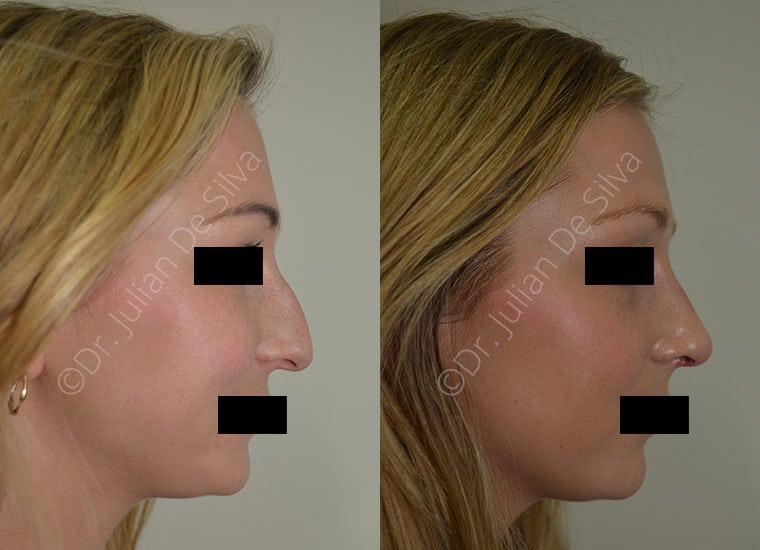
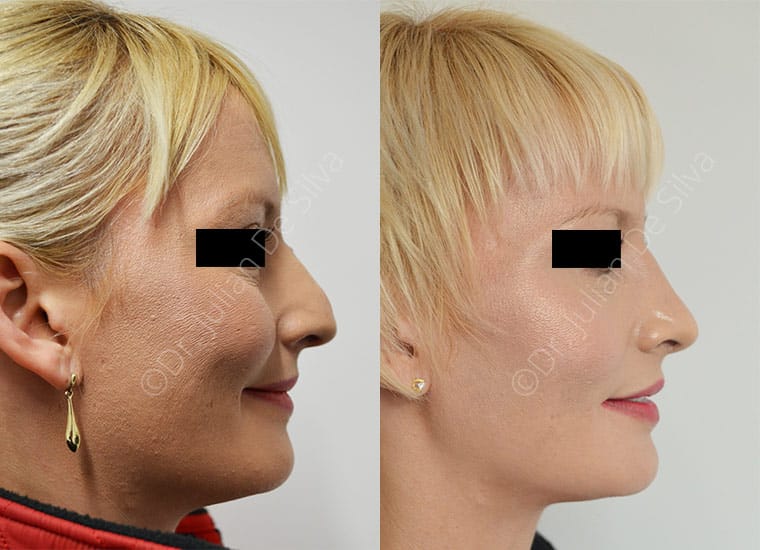

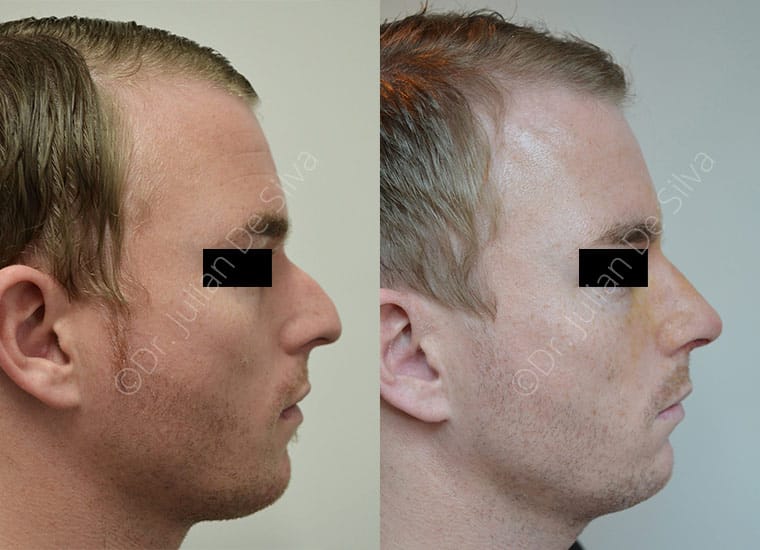
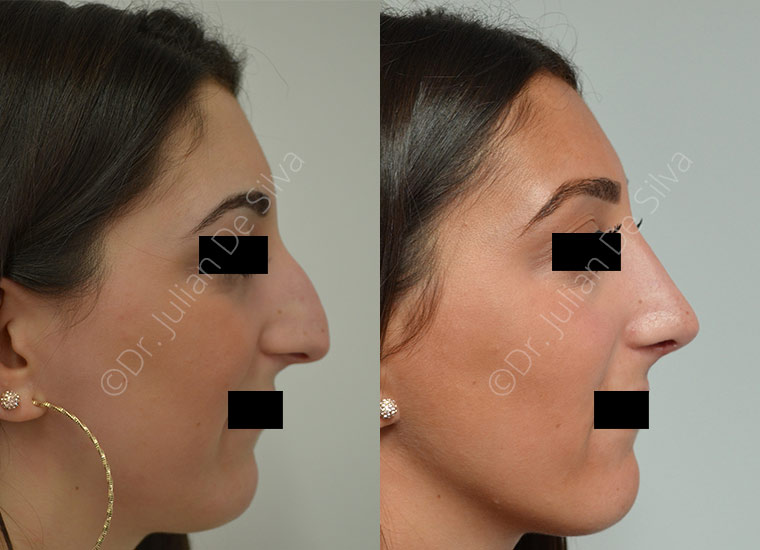
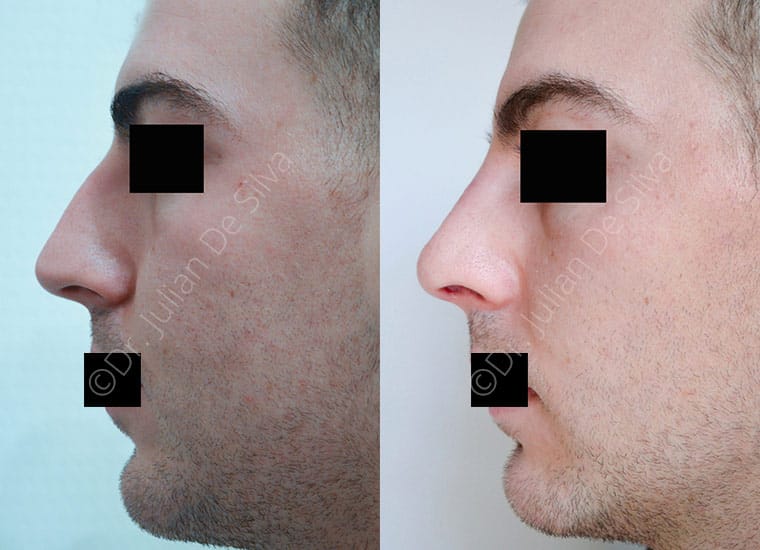
TESTIMONIAL
What our satisfied clients are saying
“From the moment I first met Dr Julian De Silva I knew I had chosen the right surgeon for me! I was apprehensive as it had taken me years to pluck up the courage to have rhinoplasty and at 69 it was a big decision! Dr De Silva has the most calming disposition, both in his manner and his speaking voice and he immediately made me feel at ease, answering my questions and explaining the procedure clearly. The day of my surgery arrived and again I really felt confident that I was in very good hands!”
Madeleine
Rhinoplasty
Frequently Asked Questions
I Live Abroad, How Can I Have Surgery?
Dr De Silva has a large number of patients that live overseas. Our specialist team can help you organise a virtual consultation and coordinate your trip to the UK.
You would need to say in the UK for approximately 10days, prior to covid, many patients would fly internationally to London to undergo rhinoplasty before returning to their home country.
We are able to utilise the latest technology to enhance your recovery including oxygen therapy, medications, lymphatic drainage and regenerative medicine.
At What Age Should You Get Rhinoplasty?
Most patients who look to undergo nose reshaping have felt self-conscious about their nose for many years before attending the consultation.
A nose that is out of balance with your face often becomes apparent in teenage years, though many patients take years to look into changing their nose.
Rhinoplasty is most commonly completed in patients aged twenty to forty-five, and Dr De Silva has completed surgery for some teenagers and patients in their 80s. Dr De Silva has had patients travel long distances and internationally for opinions on their nose, sometimes they have been refused surgery by local surgeons.
Often there may be additional factors to consider with increasing age, these can include breathing issues, drooping tip (termed ptosis) and increase irregularity, and these may require additional treatments at the same time to ensure a successful result.
Am I Too Young to Have Rhinoplasty?
Dr De Silva sees many younger patients for nose shaping in their teenage years. Many of these patients have disliked the appearance of their nose for many years before attending a consultation, and some have associated breathing issues and have been teased about their appearance.
Of key importance before considering rhinoplasty is the patient understands the implications of surgery, recovery, and expectations.
Utilising modern surgical techniques are important to ensure a long-lasting natural result. Dr De Silva completes nose reshaping on younger patients only when it is in their best interest and some patients travel long distances to London.
Do I Need to Go to Hospital?
Rhinoplasty is commonly completed in a general hospital with other surgical procedures in a general private hospital. Patients often are concerned about issues with general hospitals such as MRSA and hospital-acquired infection. Dr De Silva has built a custom state of the art facility including a private operating theatre to enable complete specialisation for every patient.
How Much Does Rhinoplasty in London Cost?
When looking for the best rhinoplasty results in London then costs should not be a consideration, but rather focus on the facility, qualification, experience, and technique of your surgeon. Given these considerations, expect to pay anywhere between £5,000 to £15,000 for a nose job in London, UK.
Can Rhinoplasty Be Combined With Other Techniques?
Dr De Silva frequently combines rhinoplasty with other facial procedures to give a natural-looking result and avoid the use of scars associated with conventional techniques:
Contact Details
Call: 020 8748 2860
Email: info@drjuliandesilva.co.uk
Address:
23 Harley Street
London, W1G 9QN, UK
Dr Julian De Silva
5 stars based on 458 reviews

Renowned expert in Facelift/Facial Cosmetic and Plastic Surgery. Signature techniques in Blepharoplasty, Rhinoplasty and Facelift surgery. Expert in revision surgery and in natural looking results

